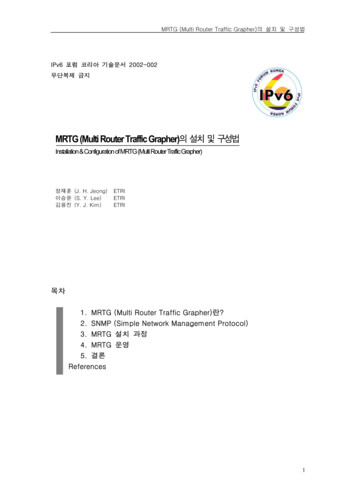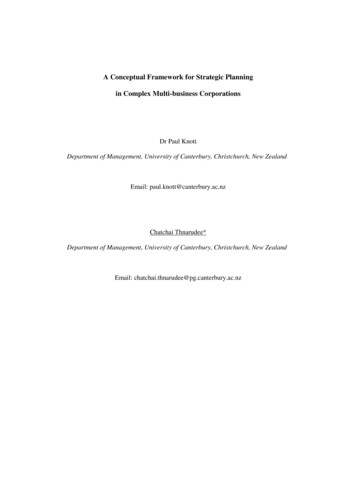
Transcription
Efficient Multi-Key Homomorphic Encryptionwith Packed Ciphertexts with Applicationto Oblivious Neural Network InferenceHao Chen1 , Wei Dai1 , Miran Kim2 , and Yongsoo Song11Microsoft Research, Redmond, USA2UTHealth, Houston, USA{haoche, wei.dai, stract. Homomorphic Encryption (HE) is a cryptosystem which supports computation on encrypted data. López-Alt et al. (STOC 2012) proposed a generalized notion of HE, called Multi-KeyHomomorphic Encryption (MKHE), which is capable of performing arithmetic operations on ciphertexts encrypted under different keys.In this paper, we present multi-key variants of two HE schemes with packed ciphertexts. We presentnew relinearization algorithms which are simpler and faster than previous method by Chen et al.(TCC 2017). We then generalize the bootstrapping techniques for HE to obtain multi-key fullyhomomorphic encryption schemes. We provide a proof-of-concept implementation of both MKHEschemes using Microsoft SEAL. For example, when the dimension of base ring is 8192, homomorphic multiplication between multi-key BFV (resp. CKKS) ciphertexts associated with four partiesfollowed by a relinearization takes about 116 (resp. 67) milliseconds.Our MKHE schemes have a wide range of applications in secure computation between multipledata providers. As a benchmark, we homomorphically classify an image using a pre-trained neuralnetwork model, where input data and model are encrypted under different keys. Our implementationtakes about 1.8 seconds to evaluate one convolutional layer followed by two fully connected layerson an encrypted image from the MNIST dataset.Keywords: Multi-key homomorphic encryption · Packed ciphertext · Ring learning with errors ·Neural networks.1IntroductionAs large amount of data are being generated and used for driving novel scientific discoveries, the effectiveand responsible utilization of large data remains to be a big challenge. This issue might be alleviatedby outsourcing to public cloud service providers with intensive computing resources. However, therestill remains a problem in privacy and security of outsourcing data and analysis. In the past few years,significant progresses have been made on cryptographic techniques for secure computation. Among thetechniques for secure computation, Multi-Party Computation (MPC) and Homomorphic Encryption (HE)have received increasing attention due to technical breakthroughs.The history of MPC dates back three decades ago [50, 5], and since then it has been intensivelystudied in the theory community. In this approach, two or more parties participate in an interactiveprotocol to compute a function on their private inputs, where only the output of the function is revealedto the parties. Recent years witnessed a large body of works on improving the practical efficiency ofMPC, and state-of-the-art protocols have achieved orders of magnitude improvements on performance(see e.g. [20, 49, 36]). However, these protocols are still inherently inefficient in terms of communicationcomplexity: the number of bits that the parties need to exchange during the protocol is proportionalto the product between the complexity of the function and the number of parties. Therefore, the highcommunication complexity remains the main bottleneck of MPC protocols.Moreover, the aforementioned MPC protocols may not be desirable for cloud-based applications, asall the parties involved need to perform local computation proportional to the complexity of the function.
2H. Chen et al.However, in practical use-cases, we cannot expect the data providers to either perform large amount ofwork or stay online during the entire protocol execution. Another model was proposed where the dataowners secret-share their data with a small number of independent servers, who perform an MPC togenerate the computation result [23, 44]. These protocols have good performance and they moved theburden from the data providers to the servers, but their privacy guarantees rely on the assumption thatthe servers do not collude.HE refers to a cryptosystem that allows computing on encrypted data without decrypting them, thusenabling securely outsourcing computation in an untrusted cloud. There have been significant technicaladvances on HE after Gentry’s first construction [24]. For example, one can encrypt multiple plaintextvalues into a single packed ciphertext, and use the single instruction multiple data (SIMD) techniques toperform operations on these values in parallel [48, 26]. Hence, HE schemes with packing techniques [7,6, 22, 16] have good amortized complexity per plaintext value, and they have been applied to privacypreserving big data analysis [39, 11, 37]. However, traditional HE schemes only allow computation onciphertexts decryptable under the same secret key. Therefore, HE does not naturally support securecomputation applications involving multiple data providers, each providing its own secret key.Fig. 1. High-level overview of the application to oblivious neural network inference.López-Alt et al. [43] proposed a Multi-Key Homomorphic Encryption (MKHE) scheme, which isa cryptographic primitive supporting arithmetic operations on ciphertexts which are not necessarilydecryptable to the same secret key. In addition to solving the aforementioned issues of HE, MKHE canbe also used to design round-efficient MPC protocols with minimal communication cost [45]. In addition,an MPC protocol from MKHE satisfies the on-the-fly MPC [43] property, where the circuit to be evaluatedcan be dynamically decided after the data providers upload their encrypted data.Despite its versatility, MKHE has been seldom used in practice. Early studies [19, 45, 46] used a multikey variant of the GSW scheme [28]. These constructions have large ciphertexts and their performancedoes not scale well with the number of parties. Previous works [8, 10] proposed MKHE schemes withshort ciphertexts, with the caveat that one ciphertext encrypts only a single bit. The only existing MKHEscheme with packed ciphertexts [13, 41] is a multi-key variant of the BGV scheme [7]. Note that all theabove studies were purely abstract with no implementation given, and it remains an open problem whetheran MKHE scheme with support for SIMD operations can be practical.1.1Our ContributionsWe design multi-key variants of the BFV [6, 22] and CKKS [16] schemes. We propose a new methodfor generating a relinearization key which is simpler and faster compared to previous technique in [13].Furthermore, we adapt the state-of-the-art bootstrapping algorithms for these schemes [12, 14, 9] to themulti-key scenario to build Multi-Key Fully Homomorphic Encryptions with packed ciphertexts. Finally,we give a proof-of-concept implementation of our multi-key schemes using Microsoft SEAL [47] and
Efficient MKHE with Packed Ciphertexts3present experimental results. To the best of our knowledge, this is the first practical implementation ofMKHE schemes that support packed ciphertexts.We also present the first viable application of MKHE that securely evaluates a pre-trained convolutional neural network (CNN) model. We build an efficient protocol where a cloud server provides on-lineprediction service to a data owner using a classifier from a model provider, while protecting the privacyof both data and model using MKHE. Our scheme with support for the multi-key operations makesit possible to achieve this at a low end-to-end latency, and near-optimal cost for the data and modelproviders, as shown in Fig. 1. The server can store numerous ciphertexts encrypted under different keys,but the computational cost of a certain task depends only on the number of parties related to the circuit.We note that our solution has the advantage over single-key HE since the ML model providers do notneed to send the unencrypted model to the server.1.2Overview of Our ConstructionLet R Z[X]/(X n 1) be the cyclotomic ring with a power-of-two dimension n, and si R be the secretof the i-th party. The starting point of the construction of a ring-based MKHE scheme is the requirementthat the resulting scheme should be able to handle homomorphic computations on ciphertexts underindependently generated secret keys. A ciphertext of our MKHE scheme associated to k different partiesis of the form ct (c0 , c1 , . . . , ck ) Rqk 1 for a modulus q, which is decryptable by the concatenatedsecret sk (1, s1 , . . . , sk ). In other words, its phase µ hct, ski (mod q) is a randomized encoding of aplaintext message m corresponding to the base scheme.Homomorphic multiplication of BFV or CKKS consists of two steps: tensor product and relinearization. The tensor product of two input ciphertexts satisfies hct1 ct2 , sk ski hct1 , ski · hct2 , ski, so it is avalid encryption under the tensor squared secret sk sk. In the relinearization step, we aim to transform(k 1)2into a canonical ciphertext encrypting the same messagethe extended ciphertext ct ct1 ct2 Rqunder sk. This step can be understood as a key-switching process which requires a special encryption ofsk sk. We note that sk sk contains entries si sj which depend on secrets of two distinct parties. Hencea relinearization key corresponding to non-linear entries cannot be generated by a single party, differentfrom the traditional HE schemes.We propose an RLWE-based cryptosystem to achieve this functionality. It looks similar to the ringvariant of GSW [28, 21] but our scheme supports some operations between ciphertexts under differentkeys. Let g Zd be an integral vector, called the gadget vector. This scheme assumes the CommonReference String (CRS) model so all parties share a random polynomial vector a Rqd . Each partyi generates a special encryption of secret si by itself, which is a matrix Di [di,0 di,1 di,2 ] Rqd 3satisfying di,0 si · di,1 ri · g (mod q) and di,2 ri · a si · g (mod q) where ri is a small polynomialsampled from the key distribution. It is published as the evaluation key of the i-th party.We present two relinearization methods with different advantages. For each pair 1 i, j k, the firstmethod combines the i-th evaluation key Di with the j-th public key bj sj · a (mod q) to generateKi,j Rqd 3 such that Ki,j · (1, si , sj ) si sj · g (mod q). That is, Ki,j can be used to relinearize oneentry ci,j of an extended ciphertext into a triple (c00 , c0i , c0j ) such that c00 c0i s0i c0j sj ci,j si sj (mod q).This method can be viewed as a variant of the previous GSW ciphertext extension proposed in [45]. Inparticular, each row of Ki,j consists of three polynomials in Rq (compared to O(k) dimension of previousworks [13, 41]), so that the bit size of a shared relinearization key {Ki,j }1 i,j k is O(dk 2 · n log q) and thecomplexity of key generation is O(d2 k 2 ) polynomial operations modulo q (see Section 3 for details). Therelinearization algorithm repeats O(k 2 ) key-switching operations from si sj to (1, si , sj ), so its complexityis O(dk 2 ) operations in Rq . We note that Ki,j can be pre-computed before multi-key operations, and agenerated key can be reused for any computation related to the parties i and j.Our second approach directly linearizes each of the entries of an extended ciphertext by multiplyingthe j-th public key bj and i-th evaluation key Di in a recursive way. The first solution should generateand store a shared relinearization key {Ki,j }1 i k , so its space and time complexity grow quadraticallyon k. However, the second algorithm allows us to keep only the individual evaluation keys which is linearon k. Furthermore, it significantly reduces the variance of additional noise from relinearization, so that we
4H. Chen et al.SchemeLZY 19 [41]CCS19 [10]This lKeyCiphertextTimeComplexity3Õ(k n)Õ(kn)Õ(k 2 n2 )Õ(kn)Õ(kn)Õ(kn)TypeComplexityEvalKey GenMultEvalKey GenNANDEvalKey GenMultÕ(k 3 n)Õ(k 3 n)Õ(k 2 n2 )Õ(k 2 n2 ) Õ(k 2 n)Table 1. Memory (bit-size) and computational costs (number of scalar operations) of MKHE schemes. k denotesthe number of parties and n is the dimension of the (R)LWE assumption. EvalKey denotes the evaluation (orbootstrapping) keys.can use a smaller parameter while keeping the same functionality. Finally, we adapt the modulus raisingtechnique [27, 38] to the second approach to reduce the noise growth even more.As an orthogonal issue, the bootstrapping of packed MKHE schemes has not been studied in theliterature. We generalize the existing bootstrapping methods for HE schemes [25, 32, 12, 14, 9] to themulti-key setting. The main issue of generalization is that the pipeline of bootstrapping includes some advanced functionalities such as slot permutation. We resolve this issue and provide all necessary operationsby applying the multi-key-switching technique in [10] to Galois automorphism.Finally, we apply the state-of-art optimization techniques for implementing HE schemes [4, 30, 15]to our MKHE schemes for performance improvement. For example, we implement full Residue NumberSystem (RNS) variants of MKHE schemes and use an RNS-friendly decomposition method [4, 30, 15] forrelinearization, thereby avoiding expensive high-precision arithmetic.1.3Related WorksLópez-Alt et al. [43] firstly proposed an MKHE scheme based on NTRU. After that, Clear and McGoldrick [19] suggested a multi-key variant of GSW together with ciphertext extension technique todesign an MKHE scheme and it was simplified by Mukherjee and Wichs [45]. Peikert and Shiehian [46]developed two multi-hop MKHE schemes based on the same multi-key GSW scheme. However, theseschemes could encrypt only a single bit in a huge extended GSW ciphertext.Brakerski and Perlman [8] suggested an MKHE scheme with short (LWE-based) ciphertexts, however,its asymptotic/concrete efficiency has not been presented clearly. Chen, Chillotti and Song [10] proposedan improved scheme by applying the framework of TFHE [17] with the first implementation of MKHEprimitive. However, this scheme does not support the packing technique, thereby resulting in a largeexpansion rate similar to TFHE.The most relevant studies are by Chen et al. [13] and Li et al. [41]. They designed multi-key variants ofBGV [7] by generating a relinearization key based on the multi-key GSW scheme. However, it consists ofO(k 2 ) key-switching keys from si sj to the ordinary key each of which has O(k) components. In addition,they did not provide any implementation result or analysis about concrete performance. Our work isan extension of these researches in the sense that our relinearization method and other optimizationtechniques can be applied to BGV as well. We also stress that the performance of previous batch MKHEschemes can be improved by observing the sparsity of evaluation keys, but this point was not pointed outin the manuscripts. In Table 1, we provide the performance of the recent MKHE schemes; in the contextof our work, the second method is taken into account for comparison.22.1BackgroundNotationAll logarithms are in base two unless otherwise indicated. We denote vectors in bold, e.g. a, and matricesin upper-case bold, e.g. A. We denote by hu, vi the usual dot product of two vectors u, v. For a real
Efficient MKHE with Packed Ciphertexts5number r, bre denotes the nearest integer to r, rounding upwards in case of a tie. We use x D to denotethe sampling x according to distribution D. For a finite set S, U (S) denotes the uniform distributionon S. We let λ denote the security parameter throughout the paper: all known valid attacks against thecryptographic scheme under scope should take Ω(2λ ) bit operations.2.2Multi-Key Homomorphic EncryptionA multi-key homomorphic encryption is a cryptosystem which allows us to evaluate an arithmetic circuiton ciphertexts, possibly encrypted under different keys.Let M be the message space with arithmetic structure. An MKHE scheme MKHE consists of five PPTalgorithms (Setup, KeyGen, Enc, Dec, Eval). We assume that each participating party has a reference(index) to its public and secret keys. A multi-key ciphertext implicitly contains an ordered set T {id1 , . . . , idk } of associated references. For example, a fresh ciphertext ct MKHE.Enc(µ; pkid ) correspondsto a single-element set T {id} but the size of reference set gets larger as the computation betweenciphertexts from different parties progresses. Setup: pp MKHE.Setup(1λ ). Takes the security parameter as an input and returns the public parameterization. We assume that all the other algorithms implicitly take pp as an input . Key Generation: (sk, pk) MKHE.KeyGen(pp). Outputs a pair of secret and public keys. Encryption: ct MKHE.Enc(µ; pk). Encrypts a plaintext µ M and outputs a ciphertext ct {0, 1} . Decryption: µ MKHE.Dec(ct; {skid }id T ). Given a ciphertext ct with the corresponding sequence ofsecret keys, outputs a plaintext µ. Homomorphic evaluation:ct MKHE.Eval(C, (ct1 , . . . , ct ), {pkid }id T ).Given a circuit C, a tuple of multi-key ciphertexts (ct1 , . . . , ct ) and the corresponding set of public keys{pkid }id T , outputs a ciphertext ct. Its reference set is the union T T1 · · · T of reference sets Tj ofthe input ciphertexts ctj for 1 j .Semantic Security. For any two messages µ0 , µ1 M, the distributions {MKHE.Enc(µi ; pk)} for i 0, 1should be computationally indistinguishable where pp MKHE.Setup(1λ ) and (sk, pk) MKHE.KeyGen(pp).Correctness and Compactness. An MKHE scheme is compact if the size of a ciphertext relevant tok parties is bounded by poly(λ, k) for a fixed polynomial poly(·, ·).For 1 j , let ctj be a ciphertext (with reference set Tj ) such that MKHE.Dec(ctj , {skid }id Tj ) µj .Let C : M M be a circuit and ct MKHE.Eval(C, (ct1 , . . . , ct ), {pkid }id T ) for T T1 · · · T .Then,MKHE.Dec(ct, {skid }id T ) C(µ1 , . . . , µ )(1)with an overwhelming probability. The equality of (1) can be substituted by approximate equality similarto the CKKS scheme for approximate arithmetic [16].2.3Ring Learning with ErrorsThroughout the paper, we assume that n is a power-of-two integer and R Z[X]/(X n 1). We writeRq R/(q · R) for the residue ring of R modulo an integer q. The Ring Learning with Errors (RLWE)assumption with parameter (n, q, χ, ψ) is that given any polynomial number of samples of the form(ai , bi s · ai ei ) Rq2 , where ai is uniformly random in Rq , s is chosen from the key distribution χ overRq , and ei is drawn from the error distribution ψ over R, the bi ’s are computationally indistinguishablefrom uniformly random elements of Rq .
62.4H. Chen et al.Gadget DecompositionLet g (gi ) Zd be a gadget vector and q an integer. The gadget decomposition, denoted by g 1 , is afunction from Rq to Rd which transforms an element a Rq into a vector u (u0 , . . . , ud 1 ) Rd ofPd 1small polynomials such that a i 0 gi · ui (mod q).The gadget decomposition technique is widely used in the construction of HE schemes. For example, homomorphic evaluation of a nonlinear circuit is based on the key-switching technique and most ofHE schemes exploit various gadget decomposition method to control the noise growth. There have beensuggested in the literature various decomposition methods such as bit decomposition [6, 7], base decomposition [21, 17] and RNS-based decomposition [4, 30]. Our implementation exploits an RNS-friendlydecomposition for the efficiency.3Relinearizing Multi-key CiphertextsThis section provides a high-level description of our MKHE schemes and explain how to perform therelinearization procedures which are core operations in homomorphic arithmetic.3.1Overview of HEs with Packed CiphertextsIn recent years, there have been remarkable advances in the performance of HE schemes. For example,the ciphertext packing technique allows us to encrypt multiple data in a single ciphertext and performparallel homomo
miran.kim@uth.tmc.edu Abstract. Homomorphic Encryption (HE) is a cryptosystem which supports computation on en-crypted data. L opez-Alt et al. (STOC 2012) proposed a generalized notion of HE, called Multi-Key Homomorphic Encryption (MKHE), which is capable of performing arithmetic










